All told, more than $4 billion will be spent on electing people to office in 2014. Both the amount and type of money has three significant implications for the political process:
1. The increased role of super PAC money is having a declining impact on the role of the two major political parties.
When the Supreme Court ruled on the Citizens United case in early 2010, many predicted it would weaken the two political parties. They were correct.
This year, both of the major political party committees, the Republican National Committee and the Democratic National Committee, will raise less than they did in 2010. According to the CRP, The DNC will raise almost $30 million less this year and the RNC $20 million less than the last midterm.
Read MoreHas the GOP hit a tipping point?
Nearly every other category of spending is going up, yet the parties are raising fewer dollars. This means state parties run smaller grassroots programs and ultimately hire fewer staff. With fewer staff, candidate recruitment at the local level will suffer, and both parties will have a weaker bench of experienced public servants.
When state parties are weaker, state super PACs will fill the void — creating a loss of continuity from year to year. If this trend continues, the national parties will be reduced to simply putting on national conventions and raising money for presidential campaigns.
2. The people who put their names on the ballot are no longer in control of what issues their campaign is about.
The CRP projects outside groups will spend a total of $689 million by Election Day 2014. While much of this money is concentrated in the top 25 or so outside organizations (out of 429 groups who've spent money), it means someone other than the candidate, his or her campaign staff, or the party is making decisions about what issues are talked about, significantly diminishing the meaningful control candidates have over their own campaign messaging.
In fact, super PACs already have more say in campaigns than the parties and candidates do: super PACs will outspend the actual candidates in eight of the 10 most competitive Senate campaigns this cycle (and, assuming Louisiana goes to a December 4 runoff, it is expected outside spending will surpass candidate spending there as well).
Read MoreOp-ed: The election could come down to one issue
Total spending by all parties in North Carolina's Senate race topped $100 million on Wednesday, according to CBS News, marking the first time a Senate race has ever crossed the $100 million mark; $72 million of this was spent by outside groups.
When super PACs run ads in primaries (also a growing trend), candidates often feel forced to track to the right or left to win. Many of these candidates will have boxed themselves in on issues before they are even sworn into office. There are many reasons for the gridlock we see today, but outside money, particularly in primaries, is at least partially the cause.
3.The rise of super PACs means we now live in a period of permanent campaigning.
Campaign politics is no longer a seasonal business.
It is approximated that $1.4 billion was spent on the 2000 presidential election. Eight years later, an estimated $2.8 billion was spent on presidential election activity by both Republican and Democratic causes. If that eight-year growth continues, spending on the 2016 election cycle will surpass the $5 billion mark.
Read MoreBarney Frank's warning for Wall Street
Hillary Clinton already has several super PACs associated with — and raising money for — her potential run for the presidency. Similarly, of the likely 10 or 12 GOP candidates, each will have a super PAC supporting him or her as well. Several of these super PACs, fueled by a few large donors, will spend more than the candidates themselves.




